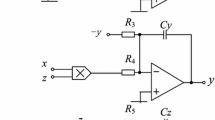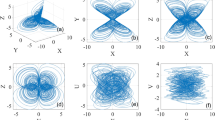Abstract
A new hyper-chaotic system is presented in this paper by adding a smooth flux-controlled memristor and a cross-product item into a three-dimensional autonomous chaotic system. It is exciting that this new memristive system can show a four-wing hyper-chaotic attractor with a line equilibrium. The dynamical behaviors of the proposed system are analyzed by Lyapunov exponents, bifurcation diagram and Poincaré maps. Then, by using the topological horseshoe theory and computer-assisted proof, the existence of hyperchaos in the system is verified theoretically. Finally, an electronic circuit is designed to implement the hyper-chaotic memristive system.











Similar content being viewed by others
References
Udaltsov, V., et al.: Communicating with hyperchaos: the dynamics of a DNLF emitter and recovery of transmitted information. Opt. Spectrosc. 95, 114–118 (2003)
Vicente, R., Daudén, J., Colet, P., Toral, R.: Analysis and characterization of the hyperchaos generated by a semiconductor laser subject to a delayed feedback loop. IEEE J. Quantum Electron. 41, 541–548 (2005)
Cafagna, D., Grassi, G.: New 3D-scroll attractors in hyperchaotic Chua’s circuits forming a ring. Int. J. Bifurc. Chaos 13, 2889–2903 (2003)
Hsieh, J.-Y., Hwang, C.-C., Wang, A.-P., Li, W.-J.: Controlling hyperchaos of the Rossler system. Int. J. Control 72, 882–886 (1999)
Grassi, G., Mascolo, S.: Nonlinear observer design to synchronize hyperchaotic systems via a scalar signal. IEEE Trans. Circuits Syst. I Fundam. Theory Appl. 44, 1011–1013 (1997)
Rossler, O.: An equation for hyperchaos. Phys. Lett. A. 71, 155–157 (1979)
Kapitaniak, T., Chua, L.O.: Hyperchaotic attractors of unidirectionally-coupled Chuas circuits. Int. J. Bifurc. Chaos 4, 477–482 (1994)
Chua, L.O.: Memristor-the missing circuit element. IEEE Trans. Circuit Theory 18, 507–519 (1971)
Strukov, D.B., Snider, G.S., Stewart, D.R., Williams, R.S.: The missing memristor found. Nature 453, 80–83 (2008)
Itoh, M., Chua, L.O.: Memristor oscillators. Int. J. Bifurc. Chaos 18, 3183–3206 (2008)
Petras, I., Chen, Y.Q., Coopmans, C.: Fractional-order memristor-based Chua’s circuit. IEEE Trans. Circuits Syst. II Express Briefs 57, 975–979 (2010)
Muthuswamy, B., Chua, L.O.: Simplest chaotic circuit. Int. J. Bifurc. Chaos 20, 1567–1580 (2010)
Grassi, G., Severance, F.L., Miller, D.A.: Multi-wing hyperchaotic attractors from coupled Lorenz systems. Chaos Solitons Fractals 41, 284–291 (2009)
Cafagna, D., Grassi, G.: Fractional-order chaos: a novel four-wing attractor in coupled Lorenz systems. Int. J. Bifurc. Chaos 19, 3329–3338 (2009)
Grassi, G., Severance, F.L., Mashev, E.D., Bazuin, B.J., Miller, D.A.: Generation of a four-wing chaotic attractor by two weakly-coupled Lorenz systems. Int. J. Bifurc. Chaos 18, 2089–2094 (2008)
Liu, W., Chen, G.: Can a three-dimensional smooth autonomous quadratic chaotic system generate a single four-scroll attractor? Int. J. Bifurc. Chaos 14, 1395–1403 (2004)
Teng, L., Iu, H.H., Wang, X., Wang, X.: Chaotic behavior in fractional-order memristor-based simplest chaotic circuit using fourth degree polynomial. Nonlinear Dyn. 77, 231–241 (2014)
Cafagna, D., Grassi, G.: On the simplest fractional-order memristor-based chaotic system. Nonlinear Dyn. 70, 1185–1197 (2012)
Li, Q., Tang, S., Zeng, H., Zhou, T.: On hyperchaos in a small memristive neural network. Nonlinear Dyn. 78, 1087–1099 (2014)
Bo-Cheng, B., Zhong, L., Jian-Ping, X.: Dynamical analysis of memristor chaotic oscillator. Chin. J. Phys. 59, 3785–3793 (2010)
Fitch, A.L., Yu, D., Iu, H.H., Sreeram, V.: Hyperchaos in a memristor-based modified canonical Chua’s circuit. Int. J. Bifurc. Chaos 22, 1250133 (2012)
Iu, H.H.-C., Yu, D., Fitch, A.L., Sreeram, V., Chen, H.: Controlling chaos in a memristor based circuit using a Twin-T notch filter. IEEE Trans. Circuits Syst. I Regul. Pap. 58, 1337–1344 (2011)
Muthuswamy, B.: Implementing memristor based chaotic circuits. Int. J. Bifurc. Chaos 20, 1335–1350 (2010)
Müller, P.C.: Calculation of Lyapunov exponents for dynamic systems with discontinuities. Chaos Solitons Fractals 5, 1671–1681 (1995)
Björck, Ǎ.: Numerics of gram-schmidt orthogonalization. Linear Algebra Appl. 197, 297–316 (1994)
Dieci, L., Van Vleck, E.S.: Computation of a few Lyapunov exponents for continuous and discrete dynamical systems. Appl. Numer. Math. 17, 275–291 (1995)
Wolf, A., Swift, J.B., Swinney, H.L., Vastano, J.A.: Determining Lyapunov exponents from a time series. Phys. D Nonlinear Phenom. 16, 285–317 (1985)
Qi, G., Chen, G., van Wyk, M.A., van Wyk, B.J., Zhang, Y.: A four-wing chaotic attractor generated from a new 3-D quadratic autonomous system. Chaos Solitons Fractals 38, 705–721 (2008)
Cang, S., Qi, G., Chen, Z.: A four-wing hyper-chaotic attractor and transient chaos generated from a new 4-D quadratic autonomous system. Nonlinear Dyn. 59, 515–527 (2010)
Qi, G., Chen, G.: Analysis and circuit implementation of a new 4D chaotic system. Phys. Lett. A 352, 386–397 (2006)
Yang, X.-S., Tang, Y.: Horseshoes in piecewise continuous maps. Chaos Solitons Fractals 19, 841–845 (2004)
Yang, X.-S.: Metric horseshoes. Chaos Solitons Fractals 20, 1149–1156 (2004)
Yang, X.-S., Li, Q.: Existence of horseshoe in a foodweb model. Int. J. Bifurc. Chaos 14, 1847–1852 (2004)
Huang, Y., Yang, X.-S.: Horseshoes in modified Chen’s attractors. Chaos Solitons Fractals 26, 79–85 (2005)
Qing-Du, L., Song, T.: Algorithm for finding horseshoes in three-dimensional hyperchaotic maps and its application. Chin. J. Phys. 62, 020510 (2013)
Yanchuk, S., Kapitaniak, T.: Symmetry-increasing bifurcation as a predictor of a chaos-hyperchaos transition in coupled systems. Phys. Rev. E 64, 056235 (2001)
Yanchuk, S., Kapitaniak, T.: Chaos-hyperchaos transition in coupled Rössler systems. Phys. Lett. A 290, 139–144 (2001)
Kapitaniak, T., Maistrenko, Y., Popovych, S.: Chaos-hyperchaos transition. Phys. Rev. E 62, 1972 (2000)
Li, Q., Tang, S., Yang, X.-S.: Hyperchaotic set in continuous chaos-hyperchaos transition. Commun. Nonlinear Sci. Numer. Simul. 19, 3718–3734 (2014)
Robinson, C.: Dynamical Systems: Stability, Symbolic Dynamics, and Chaos, vol. 28. CRC Press, Boca Raton (1999)
Acknowledgments
This work is partially supported by Natural Science Foundation of China Grants No. 61174094, Tianjin Nature Science Foundation Grant No. 14JCYBJC18700 and Shandong Provincial Natural Science Foundation Grant No. ZR2012FM034.
Author information
Authors and Affiliations
Corresponding author
Appendices
Appendix 1. A theorem of topological horseshoe
Let \(D\) be a compact region of \({R^q}\), and \(D_i = 1,2,\ldots ,p\), be compact subsets of \(D\). For each \({D_i}\), let \(D_i^1\) and \(D_i^2\) be its two fixed disjointed connected nonempty compact subsets contained in the boundary of \(D_i\). Let \(f:{D_i} \rightarrow {R^q}\) be a piecewise continuous map which is continuous on each \({D_i}\).
Definition 1
[35] A connected subset \(S\) of \({D_i}\) is said to be a separation of \(D_i^1\) and \(D_i^2\), if for any connected subset \(l \subset {D_i}\) with \(l \cap D_i^1 \ne \emptyset \) and \(l \cap D_i^2 \ne \emptyset \), we have \(l \cap S \ne \emptyset \).
Definition 2
[35] We say that \(f:{D_i} \mapsto {D_j}\) is codimension-one crossing with respect to two pairs \((D_i^1,D_i^2)\) and \((D_j^1,D_j^2)\), if \(f(S) \cap {D_j}\) is also a separation of \((D_j^1,D_j^2)\) for each separation \(S\) of \((D_j^1,D_j^2)\).
Theorem 1
[34, 35] If the codimension-one crossing relation \(f:{D_i} \mapsto {D_j}\), holds for \(1 \le i,j \le m\), then there exists a compact invariant set \(K \subset D\), such that \(f|K\) is semiconjugate to the m-shift. Here, the \(m\)-shift is usually denoted by \(\sigma |\sum p\), which is also called the Bernoulli m-shift. The symbolic series space \(\sum p \) is compact, totally disconnected and perfect. A set having these three properties is often defined as a Cantor set, and such a Cantor set frequently appears in the characterization of complex structures of chaotic invariant sets.
Theorem 2
[40] Let \(X\) be a compact metric space and \(f:X \rightarrow X\) be a continuous map. If there exists an invariant set \(K \subset X\) such that \(f|K\) is semiconjugate to the m-shift \(\sigma |p\), then the entropy of \(f\),
In addition, for every positive integer \(k\),
When \(p > 1\), the shift map \(s\) has a positive topological entropy and, therefore, is sensitive to initial conditions, i.e., chaotic. Then, it follows that \(f\) must be chaotic, too.
Sometimes in verifying existence of chaos, the Proposition 1 in this theorem is not easy to be satisfied in practice. So we have the following corollary:
Corollary 1
[35] Suppose that the map \(f:D \rightarrow X\) satisfies the following assumptions:
-
1.
There exists two mutually disjoint compact subsets \({D_1}\) and \({D_2}\) of \(D\), and \({f^\alpha }|{D_1}\) and \({f^\beta }|{D_1}\) are homeomorphisms, where \(\alpha \) and \(\beta \) are positive integers.
-
2.
\({f^\alpha }({D_1}) \mapsto {D_1}\), \({f^\alpha }({D_1}) \mapsto {D_2}\) and \({f^\beta }({D_2}) \mapsto {D_1}\). Then, there exists a compact invariant set \(K \subset D\), such that \({f^{2\alpha + \beta }}|K\) is semiconjugate to 2-shift dynamics, and \({1 \over {2\alpha +\beta }}\log 2\).
Appendix 2. The four vertices of subset \({A_{zou}}\) and \({B_{zou}}\) in terms of \((z,u)\)
When \(k = 7.5\), the four vertices of subset \({A_{zou}}\) are
and the four vertices of subset \({B_{zou}}\) are
When \(k = 4\), the four vertices of subset \({A_{zou}}\) are
and the four vertices of subset \({B_{zou}}\) are
When \(k = 2.5\), the four vertices of subset \({A_{zou}}\) are
and the four vertices of subset \({B_{zou}}\) are
Rights and permissions
About this article
Cite this article
Ma, J., Chen, Z., Wang, Z. et al. A four-wing hyper-chaotic attractor generated from a 4-D memristive system with a line equilibrium. Nonlinear Dyn 81, 1275–1288 (2015). https://doi.org/10.1007/s11071-015-2067-4
Received:
Accepted:
Published:
Issue Date:
DOI: https://doi.org/10.1007/s11071-015-2067-4




